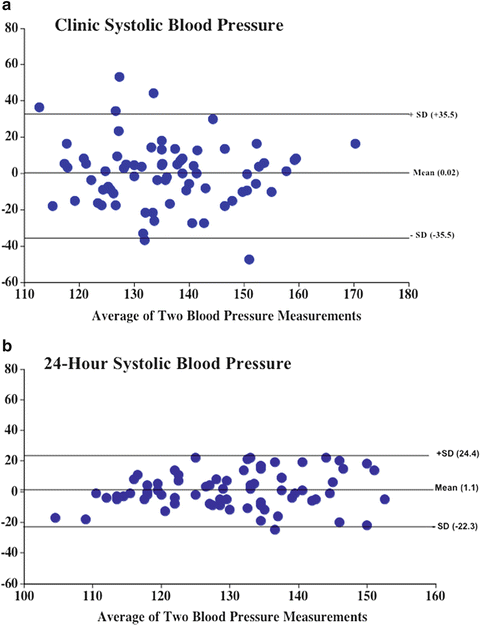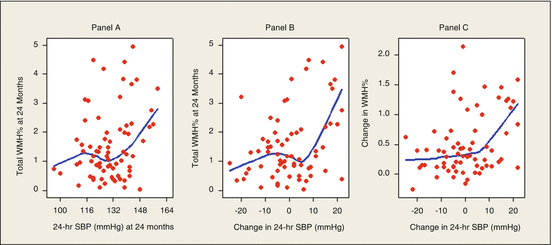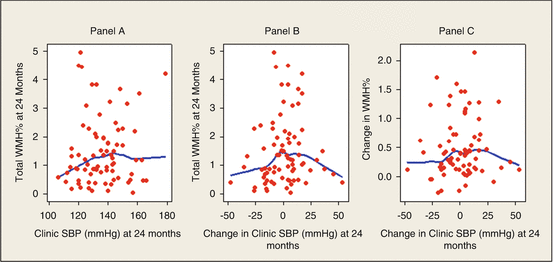BP parameter (mmHg)
Initial study (mean BP)
Two-year study (mean BP)
Changes between study periods
P-value between study periods
Standard deviation of the differences
Repeatability coefficient (RC)
Clinic systolic
136
136
0.02
0.990
17.8*
35.5*
Clinic diastolic
71
68
−2.9
0.008
9.0*
18.0*
Clinic PP
65
68
2.9
0.080
14
28
24 h systolic
130
131
1.1
0.433
11.7
23.3
24 h diastolic
66
67
0.2
0.814
6.0
12.0
24 h PP
63
64
0.92
0.270
7.1
14.2
Awake systolic
132
132
0.5
0.754
12.7**
25.5**
Awake diastolic
68
68
0.04
0.956
6.4**
12.8**
Awake PP
63
64
0.50
0.599
8.0
16.0
Sleep systolic
122
125
3.2
0.052
13.7**
27.5**
Sleep diastolic
60
60
0.72
0.441
7.8
15.6
Sleep PP
62
64
2.5
0.016
8.7
17.4
Pre-awake systolic
126
129
4.3
0.036
16.7
33.4
Pre-awake diastolic
62
63
1.6
0.191
9.9
19.9
Pre-awake PP
64
66
2.7
0.065
12.0
24
Post- awake systolic
134
138
4.3
0.066
19.4
38.9
Post-awake diastolic
72
71
−0.44
0.726
10.4
20.9
Post-awake PP
62
67
4.7
0.011
15.4
30.8

Fig. 11.1
Limits of agreement for the office systolic BP in a very elderly cohort taken 2 years apart (a) and for systolic BP taken by 24-h BP monitoring (b) using the methods of Bland–Altman (Adapted from Campbell et al. [36] with permission)
Due to the improved reproducibility of ambulatory BP (versus office BP) in older people, the sample size required in clinical trials will be much smaller if 24-h BP is the primary efficacy end point rather than the office BP [37]. Table 11.2 shows sample size calculations for a very elderly population being evaluated in a clinical interventional trial across a variety of estimated mean effects [36]. As shown in the Table, a much larger study population would be required to detect an effect of an intervention on clinic BP versus systolic BP or pulse pressure using 24-h BP.
Table 11.2
Sample size estimation based on utility of clinic and ambulatory BP components in a clinical trial of very elderly subjects
Number of subjects required per group for systolic BP (SBP) change from baseline | |||||
|---|---|---|---|---|---|
Effect size for SBP (mmHg) | Clinic BP | 24 h SBP | Awake SBP | Sleep SBP | Early morning SBP |
3 | 553 | 239 | 281 | 327 | 656 |
4 | 311 | 135 | 158 | 184 | 370 |
5 | 199 | 86 | 101 | 118 | 236 |
7 | 102 | 44 | 52 | 60 | 121 |
9 | 62 | 27 | 31 | 36 | 73 |
Number of subjects required per group for pulse pressure change from baseline | |||||
|---|---|---|---|---|---|
Effect size for pulse pressure (mmHg) | Clinic pulse pressure | 24 h pulse pressure | Awake pulse pressure | Sleep pulse pressure | Early morning pulse pressure |
3 | 342 | 88 | 112 | 132 | 414 |
4 | 192 | 50 | 63 | 74 | 233 |
5 | 123 | 32 | 40 | 48 | 149 |
7 | 63 | 16 | 20 | 24 | 76 |
9 | 38 | 10 | 12 | 15 | 46 |
Prognostic Value of ABPM in the Elderly
Prospective cohort studies in adults have shown 24-h BP measurements to be a more robust predictor of cardiovascular risk due to hypertension than BP measured in doctor’s office [38, 39]. The superiority of ambulatory BP over conventional office BP in predicting cardiovascular outcome was reported in a meta-analysis of more than 7000 participants studied over a median period of 9.5 years [40]. However, there are few studies on subjects older than 65 years of age and even less in persons greater than 80 years of age.
In a prospective cohort study in hypertensive patients older than 65 years that had a mean follow-up period of 6.7 years [41], ABPM was shown to be a better predictor of cardiovascular mortality than clinic BP measurement with nocturnal BP values demonstrating more important relations with outcomes than the diurnal BP. After adjusting for the clinic BP values, for each 10-mmHg increase in diurnal SBP and nocturnal SBP, the relative risk of cardiovascular death rose by 10 % and 18 %, respectively. A sub-study of the Syst-Eur trial compared the prognostic significance of conventional and ambulatory BP measurement in patients >60 years of age with isolated systolic hypertension [42]. This analysis demonstrated that ambulatory systolic BP was a significant predictor of cardiovascular risk over and above conventional clinic-derived BP. Furthermore, the ability of ABPM to predict cardiovascular events is observed in patients with hypertension who also have type 2 diabetes mellitus [43]. Isolated ambulatory hypertension in presence of normal office blood pressure confers poor cardiovascular prognosis in the elderly [44].
In addition to cardiovascular disease, ambulatory BP is also a better predictor of renal and cerebrovascular disease in older people with hypertension [45]. The 24-h systolic BP plays an important role in predicting the progression of subcortical white matter hyperintensity (WMH) volume burden associated with functional decline in mobility and impairment of cognitive function in older people [46]. White and co-workers studied the importance of ambulatory BP on the progression of small vessel disease of the brain in a prospective cohort of persons between 75 and 89 years of age [47]. Ambulatory and clinic BP monitoring, magnetic resonance imaging (MRI), mobility studies, and neuropsychological testing were performed at baseline and after 24 months on the 72 subjects who completed all aspects of the study. The relationships among the changes in clinic and ambulatory BP and changes in WMH, mobility, and cognitive measures were assessed at 24 months. Changes in ambulatory systolic BP, but not clinic systolic BP, were associated with increases in WMH volume as well as with impairment of several measures of mobility and cognition. Similar associations were observed for 24-h systolic BP, awake systolic BP, and sleep systolic BP, but not for the surge between the sleep and awake time at the 24-month time point. Loess scatter plots of 24-h systolic BP and WMH demonstrated higher WMH at higher levels of 24-h systolic BP and larger changes in 24-h systolic BP over time. Larger increases in WMH were also observed with increases in 24-h systolic BP (Fig. 11.2). In contrast, similar relations between the clinic systolic or change in clinic systolic BP and changes in WMH at 24 months were not observed (Fig. 11.3).



Fig. 11.2
White matter hyperintensity (WMH) and ambulatory blood pressure (BP) in a cohort of older people (from [47] with permission). Locally weighted smoother plots of 24-h average systolic BP (SBP) and WMH lesions (as percent of total intracranial volume). (a) 24-h SBP versus WMH (%); (b) change in 24-h SBP and total WMH at 24 months and (c) change in 24-h SBP and change in WMH (%) at 24 months

Fig. 11.3
White matter hyperintensity (WMH) and clinic blood pressure (BP) in a cohort of older people (from [47] with permission). Locally weighted smoother plots of clinic systolic BP (SBP) and WMH lesions (as percent of total intracranial volume are shown. (a) Clinic SBP and total WMH (%) at 24 months; (b) change in clinic SBP and change in WMH (%) at 24 months and (c) change in 24 h SBP and change in WMH (%) at 24 months
Practical Applications of ABPM in Older Population
The feasibility of technical success of ABPM in the elderly is comparable to that seen in younger population, with similar adverse effects of sleep disturbance and mild pain and bruising during cuff inflation [48]. Extreme variations of blood pressure with intermittent periods of high and low BP are often observed with ABPM in older people [49]. As age progresses, certain patterns of blood pressure are more frequent and these are important to recognize from the point of view of clinical management [28]. White coat hypertension is more common in older versus younger population. The increases in 24-h systolic BP in elderly are associated with higher pulse pressure and higher prevalence of isolated systolic hypertension. Exaggerated BP variability and early morning BP surge is also more frequent than in younger and middle-aged patients. The circadian variation in BP is often disrupted with non-dipping pattern observed in the nighttime. Postural and postprandial hypotension are also more common in the elderly. Table 11.3 outlines some of the clinical situations where ambulatory BP monitoring may be useful in older people [50].
Table 11.3
Clinical situations where ambulatory BP monitoring in the elderly may be useful
• White coat hypertension |
• Episodic hypertension |
• Borderline hypertension with or without target organ involvement |
• Evaluation of patients refractory to therapy for hypertension |
• Symptoms of hypotension in patients on antihypertensive therapy |
• Autonomic dysfunction |
• Nocturnal hypertension |
White Coat Hypertension
White coat hypertension in untreated patients or white coat effect in treated patients was originally defined as an elevated office BP ≥140 mmHg systolic and/or ≥90 mmHg diastolic with a mean awake ambulatory BP <135/85 mmHg in untreated individuals. Latest guidelines now propose this definition for patients with office BP ≥140/90 mmHg and a mean 24-h BP <130/80 mmHg to take into account nocturnal BP since it is recognized to be superior to daytime BP in predicting cardiovascular risk [28, 33]. Furthermore, the 24-h mean BP is a more reproducible value than the awake, daytime BP values [1, 28].
White coat hypertension/white coat effect is seen in 15–25 % of the elderly and is a more common syndrome in older versus younger people [51, 52]. Indeed, age is an independent factor influencing white coat hypertension [53] and even seen more frequently in centenarians [54]. Cross-sectional and prospective cohort studies have shown repeatedly that people with white coat hypertension have a better prognosis than those with sustained hypertension outside of the clinical environment [38, 39]. In some clinical outcome studies, patients with WCH may have a slightly increased, nonsignificant cardiovascular risk compared with normotensive individuals, though in most of the studies showing this effect, the ambulatory BP of the white coat hypertensive patients was higher than in normotensive individuals [55, 56]. A meta-analysis performed by the IDACO group showed that any increased risk of future cardiovascular event in a patient with white coat hypertension was very small and substantially lower than the risk seen with either persistent hypertension or masked hypertension [57].
Several guidelines recommend ABPM in patients suspected of having white coat hypertension [1, 2, 32]. In the US, this diagnosis (ICD-9-CM code 796.2, ICD-10-CM code R03.0) is a key indication for ambulatory BP monitoring recognized for coverage by the Centers for Medicare and Medicaid Services [58].
Isolated Systolic Hypertension
A gradual rise in systolic BP attributed to increased aortic stiffness is observed as age advances. Diastolic BP peaks and plateaus in the fifth–sixth decades of life and begins to decline thereafter [59]. The pulse wave velocity used to estimate arterial distensibility correlates well with ambulatory systolic BP and may be used as a surrogate to estimate aortic stiffness [60]. Epidemiologic studies have shown that isolated systolic hypertension is seen in more than 90 % of hypertensive patients >70 years of age with a higher prevalence in women than men [61]. The 24-h systolic BP is associated with more substantial adverse cardiovascular events and mortality than the ambulatory diastolic BP [62]. The Systolic Hypertension in the Elderly Program (SHEP) , a randomized, double-blind, placebo-controlled trial on 4736 subjects >60 years of age, demonstrated that treatment of isolated systolic hypertension in older patients reduced all strokes, both fatal and nonfatal, by 36 %; all myocardial infarctions (MIs), both fatal and nonfatal, by 27 %; all coronary heart disease by 27 %; and all cardiovascular disease by 32 %. Total mortality was reduced by 13 % [6]. Ambulatory systolic BP is a better predictor of cardiovascular risk than office systolic BP. The cardiovascular risk conferred by a conventional systolic BP of 160 mmHg in the doctor’s office is similar to that associated with a 24-h, daytime or nighttime systolic BP of 142 mmHg, 145 mmHg, or 132 mmHg, respectively [42]. In addition, the pulse pressure is an independent determinant of cardiovascular risk in older persons [63]. In the population-based Framingham Heart Study of 1924 subjects between 50 and 79 years of age, pulse pressure was superior to systolic or diastolic BP in predicting coronary artery disease risk [64]. Ambulatory pulse pressure has also been directly associated with cardiovascular risk [65].
Circadian Variation of Blood Pressure
The circadian pattern of blood pressure and heart rate observed in humans correlates with cardiovascular events, including both myocardial infarction and stroke [66]. Reduction of about 10–30 % of blood pressure is observed during sleep relative to the awake period in majority of normotensive and hypertensive people. This is followed by a rise in BP upon awakening which coincides with the transition from sleep to wakefulness [67].
A non-dipping pattern which is defined as a reduced or absent decline in sleep BP (generally less than 10 % decline) is seen in 25–35 % of hypertensive people and is more commonly seen in older people, both in men, women, and centenarian patients [68–71]. Increasing age is observed to be an independent marker of non-dipping after correction for confounding factors of diabetes, reduced glomerular filtration rate, low HDL-cholesterol, and elevated urinary albumin excretion [72]. This BP pattern is associated with increased target organ damage including left ventricular hypertrophy, albuminuria, and small vessel disease of the brain [25, 73, 74]. Cardiovascular prognosis is worse in elderly non-dippers with ISH than with dipper profiles [42]. Patients lacking a nocturnal decline in the BP are prone to developing congestive heart failure, myocardial infarction, stroke, and progression to end-stage renal failure. Increased incidence of fatal and non-fatal CV events is also observed in association with blunted decline in nocturnal BP [75–77].
Studies have shown poor reproducibility of the nocturnal dipping status [78, 79]. Absolute nocturnal BP values are more reproducible than the categories of dippers and non-dippers. The study observing reproducibility of ambulatory BP in elderly subjects by Campbell et al. found substantial variability in the dipping status over a period of 2 years [36]. Changes in hypertensive status based on absolute nocturnal systolic BP demonstrated improved reproducibility compared with categorical changes.
< div class='tao-gold-member'>
Only gold members can continue reading. Log In or Register to continue
Stay updated, free articles. Join our Telegram channel

Full access? Get Clinical Tree


